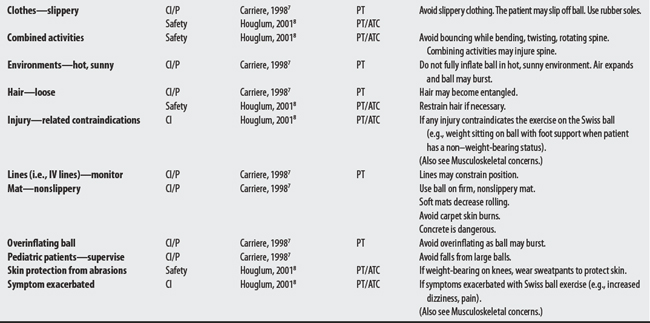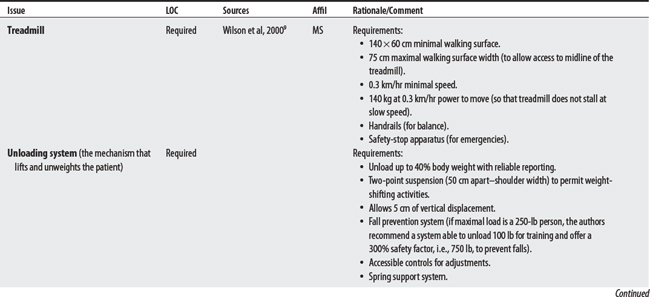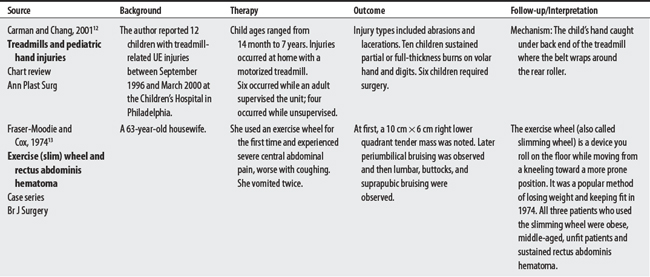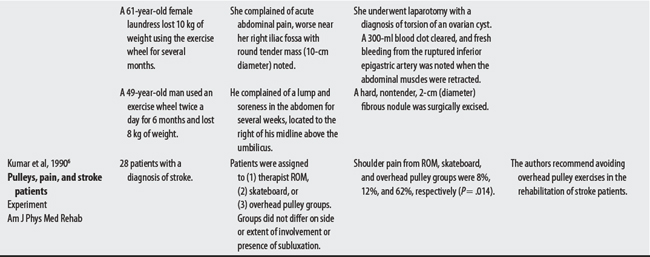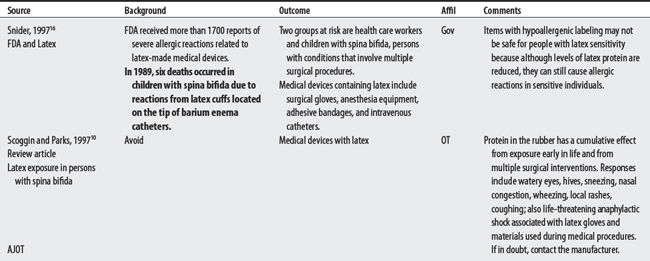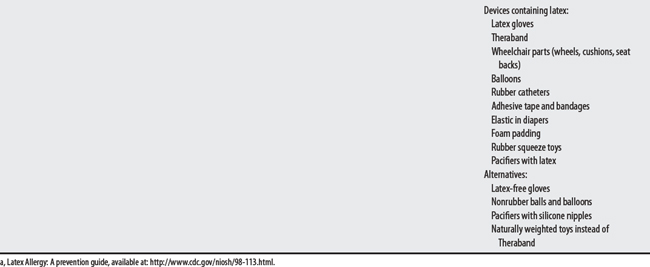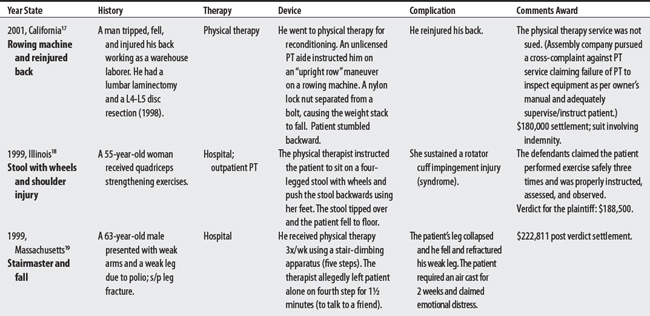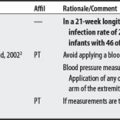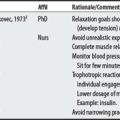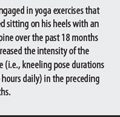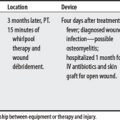Chapter 30 Exercise Equipment
This section includes advice/concerns for therapeutic or exercise equipment commonly found in the gym of a physical rehabilitation facility and include finger ladders, free and machine weights, hand blocks, overhead pulleys, skate board, Swiss balls, supported treadmills, Theraband, and toys. Adverse events associated with equipment such as isokinetic machinery, treadmills, stationary bicycles, and latex materials are also reported.
SWISS BALL
A00-B99 CERTAIN INFECTIONS AND PARASITIC DISEASES
F00-F99 MENTAL AND BEHAVIORAL DISORDERS
G00-G99 DISEASES OF THE NERVOUS SYSTEM
M00-M99 DISEASES OF THE MUSCULOSKELETAL SYSTEM AND CONNECTIVE TISSUE
PROCEDURAL CONCERNS
ADVERSE EVENTS
FOOD AND DRUG ADMINISTRATION REPORTS
FDA15 (also see Testing: Isokinetic testing)
| Date | Equipment | Event |
|---|---|---|
| 6/25/99 | Kincom 125 E | A patient s/p hip fracture repair was exercising (150/75) and felt a sharp pain. A hairline fracture was reported; no malfunction was found. |
| 4/19/99 | Kincom 125 A/P | The PTA heard a “pop” on the second set of 10 repetitions of very strenuous quad exercises; patient sustained a patella fracture. No unit malfunction found. |
| 5/28/97 | Cybex | During passive mode exercise of the left knee (flexion and extension), the knee bent further than anticipated. The mechanical stop was not set. |
| 5/03/95 | Cybex | A patient with a surgical repair (no details) felt pain while on the unit but was told to continue, resulting in reinjury and requiring surgery. |
| 12/09/94 | Lido Active Multijoint | A therapist with carpal tunnel syndrome aggravated the condition while adjusting the unit’s position. |
| 3/02/94 | Kincom 500 H | A patient sustained a hyperextension injury (no details) during a knee exercise. Note: No unit malfunction was found. |
| 2/14/94 | Kincom 125 E | A user sustained a femoral fracture during a prone knee flexion exercise for the hamstrings when the unit’s lever arm loosened, detached from the actuator, and hyperextended the user’s leg. |
| 10/29/93 | Kincom II | An employee’s hand was pinned against a computer when the unit’s actuator arm moved. |
| 7/14/93 | Kincom 125 E+ | A girl sustained an open distal phalanx fracture of the left ring finger (no details). |
| 5/10/93 | Kincom I | A man sustained a laceration to the lower leg during quadriceps testing at 80 degrees/sec in concentric/eccentric mode when the unit’s head tilted unexpectedly. |
| 3/23/93 | Kincom 500 H | A female s/p knee arthroscopic surgery was exercising and fractured the patella on her involved side (no details of protocol). |
| 11/06/92 | Kincom II | During knee testing (comparison) at 180 degrees/sec eccentric mode, the user felt knee pain (no details). |
| 7/28/92 | Kincom 125 E Plus | Patient with ACL exercising quadriceps test at 130 degrees/sec (80 to 90 degrees) started isokinetic before machine was ready and tore left ACL while it was in an isometric mode. |
| 6/26/92 | Kincom 125 E | The user fractured a patella (no details). |
| 4/01/92 | Kincom III | A patient with an autograph ACL reconstruction sustained a ruptured autograph during a 45 degrees/sec leg press when the table top slipped backward, resulting in full extension of the patient’s knee. |
| 3/11/92 | Kincom 125 E+ | During a demonstration of the unit in the passive mode, a child’s finger was caught in the actuator, resulting in 70-80% finger severance. The finger was reattached. |
| 11/19/90 | Kc 125 Muscle Testing | A patient sustained an upper chest and rib pain/laceration during left shoulder exercise when an aide unstrapped the patient from the unit while it was still in operation (programmed). |
| 11/26/86 | Kincom | The individual’s wrist broke; the cause was not determined. |
Note: FDA reports do not necessarily establish cause-effect relationships between equipment and injury. Incidences may be due to equipment or user error. Also, some reports are alleged by attorneys.
1 Kisner C, Colby LA. Therapeutic exercise: foundations and techniques, ed 3. Philadelphia: FA Davis, 1996.
2 Tan JC. Practical manual of physical medicine and rehabilitation: diagnostics, therapeutics, and basic problems. St. Louis: Mosby, 1998.
3 Baechle TR, Groves BR. Weight training: steps to success. Champaign (IL): Human Kinetics, 1992.
4 Joynt RL. Therapeutic exercise. In: Delisa JA, editor. Rehabilitation medicine: principles and practice. Philadelphia: J.B. Lippincott, 1988.
5 Moy A. Assessment of manual bed aids. DHSS Disability Equipment Assessment Programme. London: HMSO, 1987.
6 Kumar R, Metter EJ, Mehta AJ, et al. Shoulder pain in hemiplegia. The role of exercise. Am J Phys Med Rehab. 1990;69(4):205-208.
7 Carriere B. The Swiss ball: theory, basic exercise, and clinical application. Berlin: Springer, 1998.
8 Houglum PA. Therapeutic exercise for athletic injuries. Champaign (IL): Human Kinetics, 2001.
9 Wilson MS, Qureshy H, Protas EJ, et al. Equipment specifications for supported treadmill ambulation training. J Rehab Res Dev. 2000;37(4):415-422.
10 Scoggin AE, Parks KM. Latex sensitivity in children with spina bifida: implications for occupational therapy practitioners. Am J Occup Ther. 1997;51(7):608-611.
11 Merriman E, Corwin P, Ikram R. Toys are a potential source of cross-infection in general practitioners’ waiting rooms. Br J Gen Pract. 2002;52(475):138-140.
12 Carman C, Chang B. Treadmill injuries to the upper extremity in pediatric patients. Ann Plast Surg. 2001;47(1):15-19.
13 Fraser-Moodie A, Cox S. Haematoma of rectus abdominis from the use of an exercise wheel: a report of 3 cases. Br J Surg. 1974;61(7):577.
14 Consumer Product Safety Commission. Prevent Injuries to children from exercise equipment, CPSC Document No 5028. Available at: http://www.cpsc.gov/cpscpub/pubs/5028.html. Accessed November 7, 2005
15 U.S. Food and Drug Administration. Center for Device and Radiological Health. Available at: http://www.fda.gov/cdrh/mdr/. Accessed November 7, 2005
16 Snider S. FDA talk paper: Latex labeling required for medical devices 1997. Available at: http://www.fda.gov/bbs/topics/ANSWERS/ANS00826.html. Accessed November 8, 2005
17 Medical malpractice verdicts, settlements and experts, September 2001, p 45, loc 2.
18 Medical malpractice verdicts, settlements and experts, September 1999, p 37, loc 3.
19 Medical malpractice verdicts, settlements and experts, April 1999 p 38, loc 1.
20 Medical malpractice verdicts, settlements and experts, July 1997, p 41, loc 3.
21 Medical malpractice verdicts, settlements and experts, July 1997, p 41, loc 2.
a These authors’ recommendations were based on clinical experience, anthropometric data, engineering principles, and experience using three patients with chronic spinal cord injuries who met the criteria of adequate LE ROM, grade 3 or more bilateral triceps strength, ASIA scale of C or D, DTR intact at quads and Achilles tendons, and no spasticity that would interfere with standing.
b Additional recommendations (beyond required) include a ramp for wheelchair access, small speed increments (0.15 km/hr), and an ergonomically designed lift system to elevate the walking surface.














